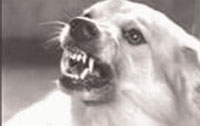1.2.2 Reservoirs of infectious agents
Many infectious agents can survive in different organisms, or on non-living objects, or in the environment. Some can only persist and multiply inside human beings, whereas others can survive in other animals, or for example in soil or water. The place where the infectious agent is normally present before infecting a new human is called a reservoir. Without reservoirs, infectious agents could not survive and hence could not be transmitted to other people. Humans and animals which serve as reservoirs for infectious agents are known as infected hosts. Two examples are people infected with HIV and with the bacteria that cause tuberculosis; these infectious agents persist and multiply in the infected hosts and can be directly transmitted to new hosts.
Animals can also be reservoirs for the infectious agents of some communicable diseases. For example, dogs are a reservoir for the virus that causes rabies (Figure 1.3). Diseases such as rabies, where the infectious agents can be transmitted from animal hosts to susceptible humans, are called zoonoses (singular, zoonosis).

Non-living things like water, food and soil can also be reservoirs for infectious agents, but they are called vehicles (not infected hosts) because they are not alive. You will learn more about them later in this study session.
Bacteria called Mycobacterium bovis can be transmitted from cattle to humans in raw milk and cause a type of tuberculosis. In this example, what is the infectious agent and the infected host or hosts?
The infectious agent is Mycobacterium bovis and the infected hosts are cattle and humans.
1.2.1 Infectious agents
